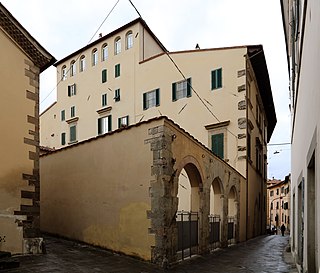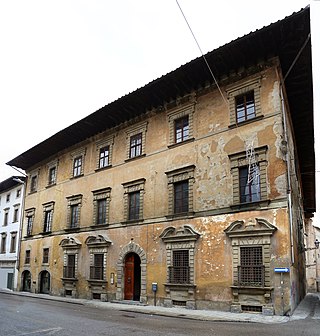Related Research Articles

Pistoia (, Italian: [pisˈtoːja] is a city and comune in the Italian region of Tuscany, the capital of a province of the same name, located about 30 kilometres west and north of Florence and is crossed by the Ombrone Pistoiese, a tributary of the River Arno. It is a typical Italian medieval city, and it attracts many tourists, especially in the summer. The city is famous throughout Europe for its plant nurseries.

The Palazzo Comunale, also known as the Palazzo del Popolo of San Gimignano has been the seat of the civic authority in the comune since the 13th century. It is located on the Piazza del Duomo close to the Collegiate Church of the Assumption of the Blessed Virgin Mary. The building and Collegiate Church are at the heart of the medieval town, and are part of the UNESCO World Heritage Site of the "Historic Centre of San Gimignano".

Palazzo Panciatichi or Palazzo del Balì is a medieval aristocratic palace located on Via Camillo Benso Cavour #35 in Pistoia, Tuscany, Italy. It a block away from the Palazzo Fioravanti.

The Palazzo del Viminale is a historic palace in Rome (Italy), seat of the Prime Minister and of the Ministry of Interior since 1925; in 1961 the Prime Minister was transferred to Palazzo Chigi.

The House of Rospigliosi is an ancient noble Italian family from Pistoia. Attested since the Middle Ages, it became wealthy through agriculture, trade and industry, reaching the apogee of its power and the high nobility status in Rome thanks to Giulio Rospigliosi, elected pope in 1667 with the name of Clement IX.

The Museo Civico di Sansepolcro or Museo Comunale is the town or comune art gallery. It is housed in a series of linked palaces, including the medieval former Palazzo della Residenza, the Palazzo dei Conservatori del Popolo and the Palazzo del Capitano o Pretorio, located on Via Niccolò Aggiunti #65, near the center of Sansepolcro, formerly Borgo Santo Sepolcro, in the Province of Arezzo, region of Tuscany, Italy. The museum was founded in 1975.

Palazzo Giustiniani or the Piccolo Colle is a palace on the Via della Dogana Vecchia and Piazza della Rotonda, in Sant'Eustachio, Rome.
The following is a timeline of the history of the city of Pistoia in the Tuscany region of Italy.

The Palazzo Sozzifanti also known as the Palazzo Buontalenti is a Renaissance-style palace located at the intersection of Via del Carmine, Via de' Rossi, Via Abbi Pazienza and Via Sant'Andrea in central Pistoia, Tuscany, Italy. The palace is used in 2019 as a temporary exhibition site by the Cassa di Risparmio di Pistoia and Pescia Foundation.

The Palazzo Marchetti is a Baroque-style palace located at Via Curtatone e Montanara in central Pistoia, Tuscany, Italy. The palace, which once served as a civic art gallery, is used in 2019 as a civic archive for various family collections of documents.

The Palazzo Ganucci Cancellieri is a late-Mannerist-style palace located at Via Curtatone e Montanara #51 in central Pistoia, Tuscany, Italy.
The Palazzo Fioravanti, formerly Palazzo Gherardi-Peraccini is a 15th-century early-Renaissance style palace located at Via Benso Cavour #20 in central Pistoia, Tuscany, Italy. It stands across the street from the north flank of the church of San Giovanni Fuorcivitas.

The Palazzo Rospigliosi a Ripa del Sale or Rospigliosi sulla Ripa is a former aristocratic palace located at Via Ripa del Sale number 3 in central Pistoia, Tuscany, Italy. The location is in a small alley adjacent to the Pistoia Cathedral, within the most ancient set of city walls. In the 19th century, the palace was donated to the diocese and now is used as both Diocesan museum and for the display of the collection donated by Clemente Rospigliosi.

The Palazzo Rospigliosi a Via del Duca is a former aristocratic palace located at Via Ripa del Sale number 3 in central Pistoia, Tuscany, Italy. The palace was the birthplace in 1600 of Giulio Rospiglio, later Pope Clement IX.

The Palazzo degli Anziani also known as the Palazzo del Comune, della Comunitá or del Giano is a Gothic-style stone palace located in the ancient historic center of Pistoia, Tuscany, Italy. The palace served as city hall for centuries; it still belongs to the comune and now mainly houses the Museo Civico d'Arte Antica.
The Palazzo Rossi is a former aristocratic palace located at Via Rossi in central Pistoia, Tuscany, Italy. The palace now serves in part to house collections and offices of the Fondazione Cassa di Risparmio di Pistoia e Pescia.

The Palazzo Pretorio or Palazzo del Podestà was initially erected to house the police and justice forces and magistrates, and is located in front of the Piazza del Duomo of Pistoia, region of Tuscany, Italy. The present building, which is mainly a Neo-Gothic construction of the 19th-century, now houses the local courts of Pistoia.

San Leone, once called the oratory or church of Santo Spirito, is a small Baroque-style Roman Catholic church located adjacent to the Vivarelli Colonna in Pistoia, region of Tuscany, Italy. In 2017, restoration of the Baroque era frescoes in the apse and ceilings were completed.
The Palazzo del Priorino is a Baroque-style palace on Via Pacini in central Pistoia, Tuscany, Italy.
Bracciolini is a surname of Italian origin. Notable people with the surname include:
References
- ↑ Pistoia e il suo territorio: Pescia e i suoi dintorni: guida del forestiero, by Giuseppe Tigri, Tipografia Cino, Pistoia (1853): page 151.